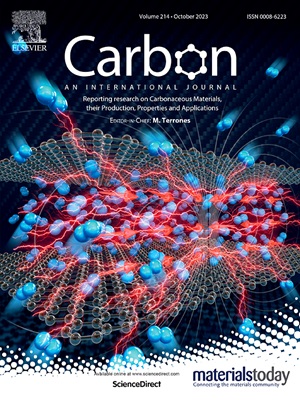Kinetically well-matched dual-carbon electrodes derived from poly(aniline-co-pyrrole) hollow nanospheres for advanced sodium-ion capacitors
IF 10.5
2区 材料科学
Q1 CHEMISTRY, PHYSICAL
引用次数: 0
Abstract
Kinetically matched electrode design is key to enhancing the high energy–power characteristics of dual-carbon sodium-ion capacitors (SICs). In this study, poly (aniline-co-pyrrole) (PACP) hollow nanospheres are used as a homogenous precursor to synthesize N/O co-doped hard carbon negative electrodes and porous carbon positive electrodes, enabling well-matched kinetic behavior between the negative and the positive electrodes. The results show that when the carbonization temperature is optimized to 1300 °C, the resulting hard carbon hollow nanospheres (HCHNS-1300) exhibits an optimal degree of graphitization suitable for sodium-ion storage, delivering a reversible capacity of 259 mAh g−1 at 0.1 A g−1 and maintaining 70 % capacity retention after 10,000 cycles at a high rate of 2 A g−1. For the positive electrode, adjusting the mass ratio of PACP to the activating agent of potassium citrate (1:4) yields porous carbon hollow nanospheres/nanosheets (PCHNS-4) with a high defect density and specific surface area (1947 m2 g−1), significantly improving the kinetics of ions adsorption/desorption. The SIC device assembled with this dual-carbon electrode system delivers a specific energy of 92.5 Wh kg−1 at a specific power of 249.7 W kg−1. Notably, even at an ultra-high specific power of 11,869.5 W kg−1, it still retains a specific energy of 82.4 Wh kg−1. The kinetic matching between the negative and positive electrodes is induced by N/O co-doping and homologous-derived hierarchical porosity engineering. This study offers an integrated material–structure–function strategy for the rational design of kinetics well-matching dual-carbon electrodes for SICs.
先进钠离子电容器用聚苯胺-共吡咯空心纳米球制备动力学匹配良好的双碳电极
动力学匹配电极设计是提高双碳钠离子电容器高能量功率特性的关键。本研究以聚苯胺-共吡咯(PACP)空心纳米球为均相前驱体,合成了N/O共掺杂硬碳负极和多孔碳正极,使负极和正极之间的动力学行为很好地匹配。结果表明,当炭化温度优化到1300℃时,制备的硬质空心碳纳米球(HCHNS-1300)具有最佳的石墨化程度,适合钠离子的存储,在0.1 ag−1时可提供259 mAh g−1的可逆容量,在2 ag−1的高速率下,在10,000次循环后仍能保持70%的容量。对于正极,调整PACP与柠檬酸钾活化剂的质量比(1:4),可以得到具有高缺陷密度和比表面积(1947 m2 g−1)的多孔碳空心纳米球/纳米片(PCHNS-4),显著改善离子吸附/解吸动力学。采用这种双碳电极系统组装的SIC器件在249.7 W kg−1的比功率下提供了92.5 Wh kg−1的比能量。值得注意的是,即使在11,869.5 W kg−1的超高比功率下,它仍然保持82.4 Wh kg−1的比能。负极和正极之间的动力学匹配是通过N/O共掺杂和同源衍生的分层孔隙工程诱导的。本研究为合理设计动力学匹配良好的sic双碳电极提供了一种材料-结构-功能一体化策略。
本文章由计算机程序翻译,如有差异,请以英文原文为准。
求助全文
约1分钟内获得全文
求助全文
来源期刊

Carbon
工程技术-材料科学:综合
CiteScore
20.80
自引率
7.30%
发文量
0
审稿时长
23 days
期刊介绍:
The journal Carbon is an international multidisciplinary forum for communicating scientific advances in the field of carbon materials. It reports new findings related to the formation, structure, properties, behaviors, and technological applications of carbons. Carbons are a broad class of ordered or disordered solid phases composed primarily of elemental carbon, including but not limited to carbon black, carbon fibers and filaments, carbon nanotubes, diamond and diamond-like carbon, fullerenes, glassy carbon, graphite, graphene, graphene-oxide, porous carbons, pyrolytic carbon, and other sp2 and non-sp2 hybridized carbon systems. Carbon is the companion title to the open access journal Carbon Trends. Relevant application areas for carbon materials include biology and medicine, catalysis, electronic, optoelectronic, spintronic, high-frequency, and photonic devices, energy storage and conversion systems, environmental applications and water treatment, smart materials and systems, and structural and thermal applications.
 求助内容:
求助内容: 应助结果提醒方式:
应助结果提醒方式:


